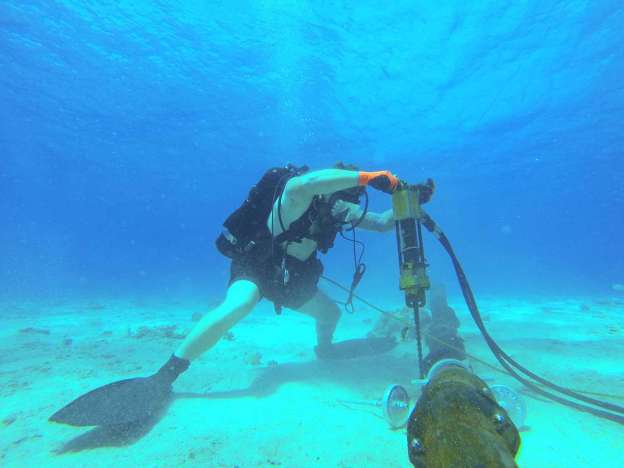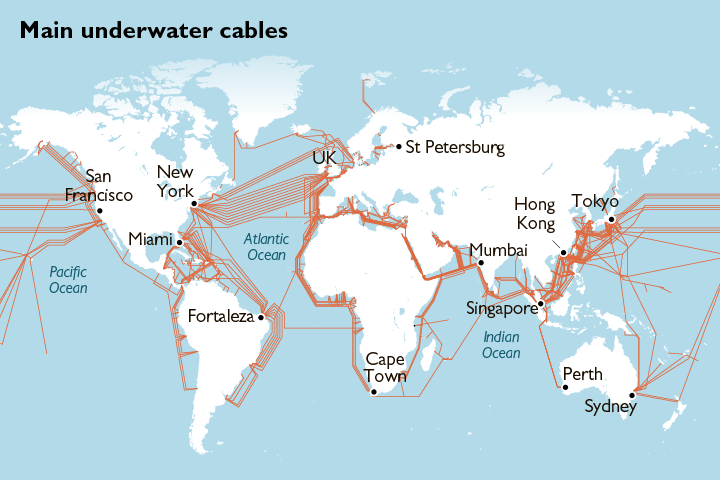On October 12, 2022 Vladimir Putin, Russia’s president, gave an ominous warning. Energy infrastructure around the world was now “at risk”, he said. Mr Putin’s warning came a month after explosions tore through Nord Stream 1 and 2, a pair of gas pipelines running from Russia to Europe under the Baltic Sea. The pipes were not in use at the time. But the ruptures left plumes of methane bubbling to the surface for days…
Subsea pipelines and cables have proliferated since the first one was laid, in 1850…There are more than 530 active or planned submarine telecoms cables around the world. Spanning over 1.3m kilometers they carry 95% of the world’s internet traffic. In November 2021, cables serving underwater acoustic sensors off the coast of northern Norway—an area frequented by Russian submarines—were cut.
Western officials say that a particular source of concern is Russia’s Main Directorate of Deep-Sea Research, known by its Russian acronym GUGI. It has a variety of spy ships and specialist submarines—most notably the Belgorod, the world’s biggest submarine, commissioned in July 2022—which can work in unusually deep water. They can deploy divers, mini-submarines or underwater drones, which could be used to cut cables.
Cable chicanery, though, is not a Russian invention. One of Britain’s first acts during the first world war was to tear up German telecoms cables laid across the Atlantic. Germany responded with attacks on Allied cables in the Pacific and Indian Oceans.
More recently, espionage has been the order of the day..I.n 2013 Edward Snowden, a contractor for the National Security Agency (NSA), America’s signals intelligence agency, revealed an Anglo-American project had tapped at least 200 fiber-optic cables around the world. Yet the seabed is not amenable to control. A paper published in 2021 noted that Estonia and other Baltic states had only a limited grasp of what was going on under the Baltic because of quirks of hydrology, scarce surveillance platforms and limited information-sharing between countries. It concluded, perhaps presciently: “It would be difficult to prevent Russian [drones] deployed in international waters from damaging critical undersea infrastructure.”…
The first step in a sabotage mission is finding the target. With big, heavy pipelines, which are typically made from concrete-lined metal sections, that is relatively easy. Older communication cables, being smaller and lighter, can shift with the currents. Newer ones are often buried, It is also increasingly possible for operators to detect tampering, through “distributed fiber-optic sensing”, which can detect vibrations in the cable or changes in its temperature. But that will not reveal whether the problem is a geological event or an inquisitive drone—or which country might have sent it. Underwater attribution is slow and difficult.
Determined attackers, in other words, are likely to get through. The effects of a successful attack will differ. Pipelines and subsea electricity cables are few in number. If one is blown up, gas, oil or electricity cannot easily be rerouted through another. Communication cables are different. The internet was designed to allow data to flow through alternative paths if one is blocked. And at least when it comes to connections between big countries, plenty of alternatives exist. At least 18 communication cables link America and Europe…There is significant redundancy on these routes. But “There’s no collective institution that records all the incidents that are going on, and what is behind them—we don’t have any statistics behind it.” according to Elisabeth Braw of the American Enterprise Institute.
Excerpts from Sabotage at Sea: Underwater Infrastructure, Economist, Oct. 22, 2022











 A real-estate magnate is financing Google’s and Facebook Inc.’s new trans-Pacific internet cable, the first such project that will be majority-owned by a single Chinese company. Wei Junkang, 56, is the main financier of the cable between Los Angeles and Hong Kong, a reflection of growing interest from China’s investors in high-tech industries. It will be the world’s highest-capacity internet link between Asia and the U.S.
A real-estate magnate is financing Google’s and Facebook Inc.’s new trans-Pacific internet cable, the first such project that will be majority-owned by a single Chinese company. Wei Junkang, 56, is the main financier of the cable between Los Angeles and Hong Kong, a reflection of growing interest from China’s investors in high-tech industries. It will be the world’s highest-capacity internet link between Asia and the U.S.

